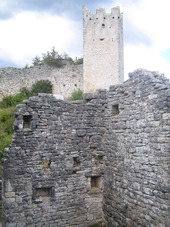to enlarge


or choose the place
from the menu below
 Rome |
 Byzantium |
 Venice |
 Vienna |
 Brioni |
 Smrikve |
 |
 |
 The ravages of time took its toll, the walls are ruined, the houses have also fallen
to ruins. With a little bit of your imagination walking trough ancient stone walls you will get the feeling of ancient people
that lived in the town.
The ravages of time took its toll, the walls are ruined, the houses have also fallen
to ruins. With a little bit of your imagination walking trough ancient stone walls you will get the feeling of ancient people
that lived in the town.
If you take the car and continue to follow the road that pass nearby the old town you will arrive nearby another small cemetery church from the 13th – 14th century that is dedicated to St. Mary of Lakuc. The church hosts some interesting medieval frescoes paintings made by Coloured master or by Giovanni degli Orefici from Buzet. The same Master also painted the walls of St. Anthony the Abot church on the other side of Dvigrad.
In Dvigrad’s photo gallery you will find several pictures of this charming and old Istrian town.
DVIGRAD – HISTORICAL OVERVIEW
Dvigrad was like many others Istrian towns and villages inhabited in prehistoric times. It was a prehistoric hill fort settlement and there were two hill forts which dominated the surrounding hills.
During the Roman period the settlement was named Duo Castra which means two towns like the meaning of todays name Dvigrad. Part of the fortification system we see today was erected in the 6th century and the last restructuring was made at the beginning of the 17th century by Marco Loredan. At the time Dvigrad was located on the border between Porec and Pula.
In the Middle Ages there were two castles on two opposite hills named Parentino and Montecastello. Parentino was destroyed for the last time in the 14th century and the ruins of Montecastello are the ruins of Dvigrad we can see today.
During the 10th century Porec’s Bishops and Count of Gorizia were in dispute over the feudal rights on Dvigrad and in 1010 the Pope Sergio IV assured the feudal rights to Porec Bishops and this was confirmed by the Emperor Enrico IV in 1077 although the owners of Dvigrad were the Aquileia Patriarchs at the time.
There were also several disputes for the ownership of the feudal rights over Dvigrad among Count of Gorizia and the Aquileia Patriarchs. At the beginning of the 13th century Dvigrad passed to Kopar and remind under Kopar government until 18th century.
Some of the people and families that had part of the feudal rights over Dvigrad in that period were: Leonardo from Bale (1200), Giroldo from Pula (1220), Sergi - Castropola from Pula (1251), Monfiorito Castropola (1265), Nascinguerra II Castropola (1278), Almerico from Motovun (1289), Pietro Castropola (1305), Odorligo and Zolino Merulo di Prata (1328), Sergio II and Nascinguerra IV Castropola (1328), Nicoletto from Motovun (1330).
In 1331 Castropola family had to leave Pula and they lost also the rights over Dvigrad. In 1366 Dvigrad was still part of the Aquileia Patriarchs’s Istrian dominions. Dvigrad continued to be involved in various wars between Venice, County of Pazin and the Aquileia Patriarchs.
At the end of the 14th century was also involved in the war between Venice and Genova. the Aquileia Patriarchs continued to rule over Dvigrad until the beginning of the 15th century.
In 1411, during the war between the Aquileia Patriarchs and Austria, Lugnano de Lugnani became on his own the Rector of Dvigrad.
In 1413 a delegation of Dvigrad’s citizens not satisfied by Lugnano de Lugnani own election went to Venice to comply and ask Doge to send a trusted Venetian Rector to Dvigrad. Soon after this visit the Venetian Doge asked Podesta’ of Koper to remove Lugnano de Lugnani.
In 1420 Dvigrad became part of Venetian dominions in Istria. The inhabitants were decimated by malaria and plague. Due to epidemics of malaria and plague, the town was abandoned.
Its last inhabitants left Dvigrad in the mid 17th century. Few decades before the inhabitants brought with them to Kanfanar liturgical and other valuable possessions. The church in Kanfanar still hosts the pulpit from St. Sophia’s Church with a relief depicting St. Sophia with two towns in her hands.
In 1616 Dvigrad was devastated during the Uskoci war between Venice and Austria and in 1631 was devastated by plague. This was the beginning of the end of life in Dvigrad.
There is a nice Latin copy of the town statute of Dvigrad translated into Croatian that dates back at the beginning of the 15th century. This and other preserved statutes of Istrian towns that testify the level of civilisation Istria had many centuries ago.